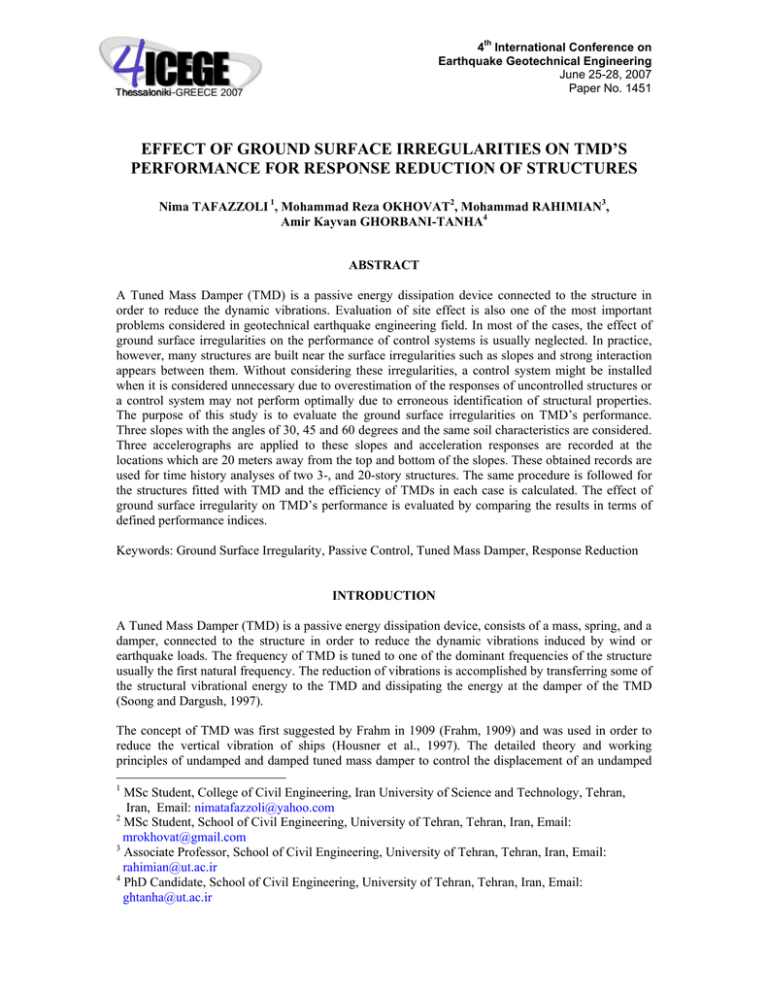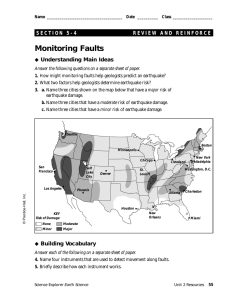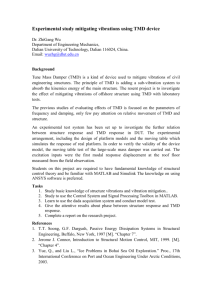EFFECT OF GROUND SURFACE IRREGULARITIES ON TMD’S
advertisement

4th International Conference on Earthquake Geotechnical Engineering June 25-28, 2007 Paper No. 1451 EFFECT OF GROUND SURFACE IRREGULARITIES ON TMD’S PERFORMANCE FOR RESPONSE REDUCTION OF STRUCTURES Nima TAFAZZOLI 1, Mohammad Reza OKHOVAT2, Mohammad RAHIMIAN3, Amir Kayvan GHORBANI-TANHA4 ABSTRACT A Tuned Mass Damper (TMD) is a passive energy dissipation device connected to the structure in order to reduce the dynamic vibrations. Evaluation of site effect is also one of the most important problems considered in geotechnical earthquake engineering field. In most of the cases, the effect of ground surface irregularities on the performance of control systems is usually neglected. In practice, however, many structures are built near the surface irregularities such as slopes and strong interaction appears between them. Without considering these irregularities, a control system might be installed when it is considered unnecessary due to overestimation of the responses of uncontrolled structures or a control system may not perform optimally due to erroneous identification of structural properties. The purpose of this study is to evaluate the ground surface irregularities on TMD’s performance. Three slopes with the angles of 30, 45 and 60 degrees and the same soil characteristics are considered. Three accelerographs are applied to these slopes and acceleration responses are recorded at the locations which are 20 meters away from the top and bottom of the slopes. These obtained records are used for time history analyses of two 3-, and 20-story structures. The same procedure is followed for the structures fitted with TMD and the efficiency of TMDs in each case is calculated. The effect of ground surface irregularity on TMD’s performance is evaluated by comparing the results in terms of defined performance indices. Keywords: Ground Surface Irregularity, Passive Control, Tuned Mass Damper, Response Reduction INTRODUCTION A Tuned Mass Damper (TMD) is a passive energy dissipation device, consists of a mass, spring, and a damper, connected to the structure in order to reduce the dynamic vibrations induced by wind or earthquake loads. The frequency of TMD is tuned to one of the dominant frequencies of the structure usually the first natural frequency. The reduction of vibrations is accomplished by transferring some of the structural vibrational energy to the TMD and dissipating the energy at the damper of the TMD (Soong and Dargush, 1997). The concept of TMD was first suggested by Frahm in 1909 (Frahm, 1909) and was used in order to reduce the vertical vibration of ships (Housner et al., 1997). The detailed theory and working principles of undamped and damped tuned mass damper to control the displacement of an undamped 1 MSc Student, College of Civil Engineering, Iran University of Science and Technology, Tehran, Iran, Email: nimatafazzoli@yahoo.com 2 MSc Student, School of Civil Engineering, University of Tehran, Tehran, Iran, Email: mrokhovat@gmail.com 3 Associate Professor, School of Civil Engineering, University of Tehran, Tehran, Iran, Email: rahimian@ut.ac.ir 4 PhD Candidate, School of Civil Engineering, University of Tehran, Tehran, Iran, Email: ghtanha@ut.ac.ir single degree-of-freedom system subjected to a harmonic force has been described by Den Hartog in his monograph (1956). He developed simple formulas for proper selection of optimum parameters of TMD. McNamara (1977) demonstrated that TMDs are effective in reducing wind-induced response of structures. Warburton (1982) derived closed-form expressions for optimum damper parameters for undamped single degree-of-freedom main system for both harmonic and white noise random excitations with force and base accelerations as input and minimization of various response parameters. Using a numerical searching procedure, Tsai and Lin (1993) obtained the optimum parameters of TMDs for steady-state response reduction of damped systems subjected to support excitations. Fujino and Abe (1993) summarized a set of design formulas for TMDs based on a perturbation technique under various type of loading conditions. Sadek et al. (1997) determined the optimum parameters of TMDs which result in seismic response reduction of structures. Okhovat et al. (2006) investigated the effectiveness of TMD on seismic response reduction of Tehran Tower. On the other hand, ground response analyses are important to predict the ground surface motions during earthquake loading and also to evaluate the earthquake induced forces which can cause the instability of earth and earth retaining structures. The effect of the earthquakes is dependent upon many factors including the geotechnical properties of the site at the proximity of the event as well as the topography and geometry of the site, source characteristics and path of the waves initiated from the earthquake. Site effect plays an important role in earthquake resistant design and must be accounted in each case. Two of the most important earthquakes in which the local site effect can be clearly seen were the 1985 Michoacan (Mexico) earthquake (Stone et al., 1987) and the 1989 Loma Prieta (California) earthquake (Seed et al., 1990). Since the early observations, the effects of site conditions on ground motions have been illustrated in earthquakes around the world. Although the local soil effect was considerably evidenced, provisions specifically accounting for site effects did not appear in building codes until the 1970s. Local site conditions can influence the important characteristics such as amplitude, frequency content and duration of the motions (Kramer, 1996). The extent of the influence of the soil depends on the geometry and material properties of the soil layers, site topography, and the characteristics of the input motion. It is well recognized that the ground motions are strongly affected by ground irregularities. Researchers have shown that in many cases with topography irregularities, one dimensional analysis can not simulate the reflection of the waves from the boundaries of the valley. The alluvium basement rock interface generates surface waves and may trap body waves in the alluvium (Finn and Nichols, 1988; Silva, 1989). These waves amplify the motion and increase the duration over that predicted by one dimensional analysis. A number of cases which show the engineering implications of valley and slope effects have been presented by Bard and Gabriel (1986). Assimaki and Gazetas (2004) performed a parametric study on the eastern bank of the Kifisos river canyon to evaluate the significance of topographic and soil effects on the seismic response of slopes. Athanasopoulos et al. (1999) studied the non-uniform distribution of damage in terms of surface topography effects by conducting seismic response analyses of a simplified two dimensional profile of the Egion town. Makra et al. (2005) studied the two dimensional model which has been constructed and validated for Euroseistest valley in northern Greece and compared the results with the obtained ones from one dimensional models. Also, comparisons were performed between the simplified and real model of the Euroseistest valley to obtain the influence of the knowledge of the local geology on site amplification simulations (Semblat et al., 2005). Moreover, Tafazzoli and Baziar (2005) investigated the site effect problem in the city of Bam in Iran and showed the importance of the knowledge of the soil characteristics and the bedrock. The two dimensional analysis of the Bam city was also studied and comparisons were performed between the results obtained from one and two dimensional modeling (Baziar et al., 2006). Although significant progress has been made in the field of structural control during the past two decades (Housner et al, 1997; Soong and Spencer, 2002; Spencer and Nagarajaiah, 2003), the effect of local soil properties such as site topography on the performance of control systems is usually neglected. Without taking this factor into account, a control system might be installed when it is considered unnecessary due to overestimation of the responses of uncontrolled structures or a control system may not perform optimally due to erroneous identification of structural properties. In this study, the effect of ground surface irregularity on TMD’s performance is evaluated. Three slopes with the angles of 30, 45 and 60 degrees and the same soil characteristics are considered. Material damping for soil analyses is of Rayleigh type and therefore frequency dependent. Three accelerographs are applied to these slopes and acceleration responses are recorded at the locations which are 20 meters away from the top and bottom of the slopes. These obtained records are used for time history analyses of two 3-, and 20-story structures. The same procedure is followed for the structures fitted with TMD and the efficiency of TMDs in each case is calculated. The effect of ground surface irregularity on TMD’s performance is evaluated by comparing the results. DESCRIPTION OF STRUCTURES AND TMDS USED Two 3- and 20- story structures are used in this paper. The mass and stiffness of stories are assumed to be similar to those of SAC Phase II Steel Project Buildings (Ohtori et al., 2004). The structures are assumed to be undamped. A single TMD is connected to the roof of each structure. Table 1 shows the first natural frequency of the structures to which the TMD has been tuned for each case. The mass ratio (µ) and TMD’s damping ratio (ξ) are also summarized in this Table. Table 1. Properties of the TMDs used 3-story First Natural Frequency (Hz) 0.99 20-story 0.26 Structure TMD's Mass ratio TMD's Damping ratio 0.02 0.07 0.05 0.07 SLOPE MODELING AND GROUND MOTION PROPERTIES In this research, three types of slope with toe angles of 30, 45, and 60 degrees are considered. The shear wave velocity of 1100 m/s, cohesion of 45 MPa, and friction angle of 40 degrees are considered as the characteristics of the soils. These high values for stiffness of the soil are considered for dynamic stability of the slope; besides in this case, the effects of topographic irregularities are more outstanding than those of soil parameters. The height of the slopes is also 50 meters. Figure 1 demonstrates the details of these slopes. Finite Difference method is used for two dimensional response analyses of the slopes. In these analyses nonlinear behavior of the soil is considered. Also, Rayleigh damping with the damping ratio of 0.05 is used. The size of mesh, used in finite difference solutions, is selected to be less than onetenth of the wavelength associated with the frequency component of the input wave. The input motion is applied to the bedrock while the vertical boundaries of the sides are placed far enough from the topographical irregularity, where free field motion could be assumed. For dynamic analyses, three earthquake consist records of El Centro, Northridge and Kobe which have been recorded on the rock outcrop and are scaled to have peak ground acceleration of 0.35g, have been applied to the bedrock of the slopes. More details about these records are given in Table 2. The maximum surface acceleration at the top and bottom of the slopes is considered as a representative of response ground motion characteristics. The distribution characteristics of this quantity at the locations with the distance of 20 meters from the top and bottom of the slopes are studied. Figure 1. Different types of the slopes Table 2. Properties of the earthquakes used for analyses Name of Record Maximum Acceleration (g) Magnitude (Mb) Duration (sec) El Centro (1940) 0.35 7.1 31.0 Kobe (1995) 0.35 6.9 50.0 Northridge (1994) 0.35 6.8 50.0 EVALUATION CRITERIA In order to evaluate the performance of the control method, both peak- and normed-based evaluation criteria are used. Small values of the evaluation criteria are generally more desirable. The first criterion is based on peak building interstory drift ratios (Othori et al., 2004). ⎧ d i (t ) ⎪ max t ,i hi ⎪ J 1 = max ⎨ max δ ⎪ ⎪⎩ ⎫ ⎪ ⎪ ⎬ ⎪ ⎪⎭ (1) over the range i = [1,3] and i = [1,20] for these buildings, where d i (t ) = interstory drift over the time history of each earthquake; hi = height of each of the associated stories; δ max = maximum interstory drift ratio of the uncontrolled structure calculated by equation of max t ,i d i (t ) hi . Second criterion is based on normed interstory drift and defined as follows ⎧ d i (t ) ⎪ max i hi ⎪ J 2 = max ⎨ max δ ⎪ ⎪⎩ ⎫ ⎪ ⎪ ⎬ ⎪ ⎪⎭ (2) where the norm, . , is computed using the following equation . ≡ 1 tf ∫ [. ] tf 0 2 dt (3) where tf is sufficiently large time to allow the response of the structure to attenuate. In this study, the duration of 100 sec is adopted for those mentioned earthquakes. Accordingly, the criteria which are related to acceleration response of the building are defined as follows where &x&a i (t ) and &x&a max ⎧ max t ,i &x&a i (t ) ⎫ ⎪ ⎪ J 3 = max ⎨ ⎬ max &x&a ⎪⎩ ⎪⎭ (4) ⎧ max i &x&a i (t ) ⎪ J 4 = max ⎨ &x&amax ⎪⎩ (5) ⎫ ⎪ ⎬ ⎪⎭ are absolute accelerations of the ith level with and without control devices respectively. NUMERICAL RESULTS Numerical analyses are performed and the results for the maximum surface acceleration at the locations with the distance of 20 meters from the top and bottom of the slopes are shown in Table 3. As it can be seen in this Table, the maximum accelerations at the recorded points are highly affected by the surface irregularities. Furthermore, the evaluation criteria for the 3- and 20-story buildings at the slopes of 30, 45, and 60 degrees are shown in the Tables 4-9. It can be understood that for 3-story structure, TMD is more efficient in the structural response improvement when the structure is located at the bottom of the slope. This statement is also true for the displacement response reduction of 20story structure but for the acceleration response reduction of 20-story structure, no clear judgment can be made. Table 3. Maximum response acceleration for different slopes 30˚ 45˚ 60˚ Name of Record Bottom (g) Top (g) Bottom (g) Top (g) Bottom (g) Top (g) El Centro 0.60 0.84 0.57 0.81 0.55 0.86 Kobe 0.43 0.90 0.47 0.94 0.51 1.01 Northridge 0.64 0.83 0.66 0.85 0.63 0.92 Table 4. Evaluation criteria for the 3-story building at the slope of 30° Name of Record Bottom Top J1 J2 J3 J4 J1 J2 J3 J4 El Centro 0.78 0.72 0.83 0.78 0.89 0.86 0.90 0.96 Kobe 0.84 0.73 0.96 0.72 0.98 0.89 0.92 0.98 Northridge 0.88 0.82 0.51 0.55 0.98 0.94 0.74 0.93 Table 5. Evaluation criteria for the 3-story building at the slope of 45° Name of Record Bottom Top J1 J2 J3 J4 J1 J2 J3 J4 El Centro 0.80 0.71 0.83 0.78 0.88 0.86 0.88 0.96 Kobe 0.83 0.77 0.74 0.82 0.97 0.91 0.93 0.98 Northridge 0.92 0.81 0.54 0.57 0.98 0.94 0.80 0.93 Table 6. Evaluation criteria for the 3-story building at the slope of 60° Name of Record Bottom Top J1 J2 J3 J4 J1 J2 J3 J4 El Centro 0.50 0.54 0.48 0.46 0.88 0.87 0.87 0.96 Kobe 0.84 0.77 0.75 0.82 0.96 0.92 0.93 0.98 Northridge 0.92 0.83 0.56 0.60 0.99 0.95 0.78 0.93 Table 7. Evaluation criteria for the 20-story building at the slope of 30° Name of Record Bottom Top J1 J2 J3 J4 J1 J2 J3 J4 El Centro 0.76 0.62 0.75 0.78 0.83 0.65 0.71 0.68 Kobe 0.75 0.57 0.79 0.61 0.86 0.63 0.89 0.66 Northridge 0.85 0.72 0.91 0.87 0.86 0.73 0.97 0.73 Table 8. Evaluation criteria for the 20-story building at the slope of 45° Name of Record Bottom Top J1 J2 J3 J4 J1 J2 J3 J4 El Centro 0.85 0.61 0.93 0.64 0.89 0.62 0.93 0.64 Kobe 0.73 0.53 0.84 0.61 0.79 0.63 0.84 0.61 Northridge 0.72 0.70 0.85 0.86 0.96 0.72 0.96 0.73 Table 9. Evaluation criteria for the 20-story building at the slope of 60° Name of Record Bottom Top J1 J2 J3 J4 J1 J2 J3 J4 El Centro 0.86 0.61 0.91 0.65 0.92 0.64 0.94 0.66 Kobe 0.73 0.54 0.79 0.61 0.78 0.64 0.77 0.67 Northridge 0.71 0.71 0.88 0.86 0.96 0.72 0.99 0.73 CONCLUSIONS In this study, the effect of ground surface irregularities on TMD’s performance was evaluated. The results show that for 3-story structure, TMD exhibits more efficiency in the structural response reduction when the structure is located at the bottom of a slope. In the case of 20-story, TMD is also more efficient in displacement response improvement when the structure is located at the bottom of the slope. This reminds the importance of considering the topography irregularities in choosing the location of the constructional site. Further investigations should be performed on TMD’s performance considering soil-structure interaction. AKNOWLEDGEMENTS The authors would like to thank Dr. Rasoul Mirghaderi, assistant professor, University of Tehran, for the generous sharing of information and facilities relevant to this research and also Mr. Babak Kamrani Moghaddam for his valuable comments and guidance. REFERENCES Assimaki, D. and Gazetas, G., “Soil and Topographic Amplification on Canyon Banks and the 1999 Athens Earthquake,” Journal of Earthquake Engineering, 8(1), 1-43, 2004 Athanasopoulos, G.A., Pelekis, P.C. and Leonidou E.A., “Effect of surface topography on seismic ground response in the Egion (Greece) 15 June 1995 earthquake,” Soil Dynamics and Earthquake Engineering, 18(2), 135-149, 1999 Bard, P.Y. and Gabriel, J.C., “The seismic response of two dimensional sedimentary deposits with large vertical velocity gradients,” Bulletin of Seismological Society of America, No. 76, 343-346, 1986 Baziar, M.H., Tafazzoli, N. and Fatemi Aghda, M., “2D evaluation of site effect in the city of Bam,” Proceedings of the 1st European Conference on Earthquake Engineering and Seismology, No. 188, Geneva, Switzerland, 2006 Den Hartog, J.P., Mechanical Vibrations, Mc-Graw-Hill, Inc., New York, NY., 1956 Finn, W.D. Liam and Nichols, A.M., “Seismic response of long period sites: Lessons from the September 19, 1985 Mexican earthquake,” Canadian Geotechnical Journal, 128-137, 1988 Frahm, H., “Device for damping vibrations of bodies,” US Patent #989958, 1909 Fujino, Y. and Abe, M., “Design formulas for tuned mass dampers based on a perturbation technique,” Earthquake Engineering and Structural Dynamics, 22, 833-854, 1993 Housner, G.W., Bergman, L.A., Caughey, T.K., Chassiakos, A.G., Claus, R.O., Masri, S.F., Skelton, R.E., Soong, T.T., Spencer, B.F. and Yao, J.T.P., “Structural Control: Past, Present and Future,” Journal of Engineering Mechanics, ASCE, 123(9), 897-971, 1997 Kramer, S.L., Geotechnical Earthquake Engineering, Prentice Hall, Upper Saddle River, New Jersey, 1996 Makra, K., Chavez-Garcia, F.J., Raptakis, D. and Pitilakis, K. “Parametric analysis of the seismic response of a 2D sedimentary valley: implications for code implementations of complex site effects,” Journal of Soil Dynamics and Earthquake Engineering, 25(4), 303-315, 2005 McNamara, R.J., “Tuned mass dampers for buildings,” Journal of the Structural Division, ASCE, 103(ST9), 1785-1798, 1977 Ohtori, Y., Christenson, R.E., Spencer, B.F. and Dyke, S.J., “Benchmark Control Problems for Seismically Excited Nonlinear Buildings,” Journal of Engineering Mechanics, ASCE, 130(4), 366385, 2004 Okhovat, M.R., Rahimian, M. and Ghorbani-Tanha, A.K., “Tuned mass damper for seismic response reduction of Tehran Tower,” Proceeding of 4th international conference on earthquake engineering, No. 132, Taipei, Taiwan, 2006 Sadek, F., Mohraz, B., Taylor, A.W. and Chung, R.M., “A method of estimating the parameters of tuned mass dampers for seismic applications,” Earthquake Engineering and Structural Dynamics, 26, 617-635, 1997 Seed, R.B., Dickenson, S.E., Peimer, M.F., Bray, J.D., Sitar, N., Mitchell, J.K., Idriss, I.M., Kayen, R.E., Krop, A., Harder, L.F. and Power, M.S., “Preliminary report on the principal geotechnical aspects of the October 17, 1989 Loma Prieta earthquake,” Report UCB/EERC-90/05, Earthquake Engineering Research Center, University of California, Berkeley, 137 pp., 1990 Silva, W.J., “Site geometry and global characteristics, state of the art report,” Proceedings of workshop on dynamic soil properties and site characterization, National science foundation and electric power research institute, Palo Alto, California, 1989 Semblat, J.F., Kham, M., Parara, E., Bard, P.Y., Pitilakis, K., Makra and K., Raptakis, D. “Seismic wave amplification: Basin geometry vs soil layering,” Journal of Soil Dynamics and Earthquake Engineering, 25(7-10), 529-538, 2005 Soong, T.T. and Spencer Jr., B.F., “Supplemental energy dissipation: state of the art and state of the art practice,” Engineering Structures, 24, 243-259, 2002 Soong, T.T. and Dargush, G.F., Passive Energy Dissipation Systems in Structural Engineering, John Wiley and Sons Ltd, England, 1997 Spencer Jr., B.F. and Nagarajaiah, S., “State of the art of structural control,” Structural Engineering, ASCE, 129(7), 845-856, 2003 Stone, W.C., Yokel, F.Y., Celebi, M., Hanks, T. and Leyendecker, E.V., “Engineering aspects of the September 19, 1985 Mexico earthquake,” NBS Building Science Series 165, National Bureau of Standards, Washington, D.C., 207 pp., 1987 Tafazzoli N. and Baziar M.H., “Evaluation of the Site Effect in the City of Bam”, Conference on Bam Earthquake, Reconstruction and Future of it, published in ASAS journal Vol.18, Bam, Iran, May 18-19, 2005 Tsai, H.C. and Lin, G.C., “Optimum tuned-mass dampers for minimizing steady-state response of support-excited and damped systems,” Earthquake Engineering and Structural Dynamics, 22, 957973, 1993 Warburton, G.B., “Optimum absorber parameters for various combinations of response and excitation parameters,” Earthquake Engineering and Structural Dynamics, 10, 381-401, 1982








